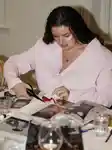These offline activities help us find purpose and feel grounded in an increasingly uncertain and online world. To set you up to achieve all your goals in 2025, we tapped vision boarding expert, Claire Foot, to help you design your dream life.
Feeling stuck on a “hamster wheel of ‘shoulds’” in her late twenties and early thirties – unsure of what she really wanted as opposed to what societal pressures told her to do – Foot embarked on a journey of reflection. Along the way, she discovered various practices that helped her gain clarity – one of which was vision boarding.

With a desire to share what she learnt with others, Foot founded Amilla Studio at the beginning of 2024. Since then she’s hosted events for more than 300 people, with a goal to build community and share the importance of ‘designing your dream life’ through visualisation (literally).


Foot says to think of manifestation as the end goal and vision boarding as a part of your self-discovery journey: “We can't manifest our dream life if we don't know what it is. So the clearer we are about what we want, the easier and quicker it will become our reality,” she explains.
Leaning on her experience as an interior designer, she likens designing your dream life to changing your space: “People understand [renovations], but they don’t grasp that we can do the exact same thing with our life,” she says, adding, “We can step into the role of designer for our lives.”
In fact, Foot applies the same approach to designing life as she would to design a home. Here’s her guide…

Let’s get physical – once a year
To avoid overwhelm, Foot recommends making annual vision boards: “If we create a five-year or 10-year board, we might look at it and think, ‘Oh, I'm so far away from that’… That then puts us in a space of lack, which is not what we want.”
And while scrolling through digital vision boards for inspiration is great, the act of creating physical boards – where you cut out images and text from print media and stick it to a piece of card – makes the process more meaningful and mindful.

The (board) limit does not exist
If you’re new to vision boarding, Foot recommends starting with one board. However, if you want to get more specific or need more clarity, you could make a board for each of the following:
Health: What do you want both your mental and physical wellbeing to look like?
Relationships: What would you like your romantic, platonic and familial relationships to feel like?
Career: How do you want your work life to look and feel?
Environment: How does both your physical space and the media you consume influence how you think and feel? Is this aligned to your values?
Adventure: Think of this as your ‘fun’ board – what lights you up inside?
Self: What are the other little things that bring you joy but might not fit onto other boards? (It could be something as small as a beautiful pair of shoes you have your eye on…)
“We don't want paralysis by analysis… so, if creating six boards is all too much, start with the most pressing area,” the expert adds.

There’s no right or wrong
So, you know which boards you’re creating, you’ve got the magazines stacked high next to you and your scissors are at the ready. Now what?
Our vision boarding expert says before you start cutting things out, make sure your mindset is right.
“Consider the beliefs that you have around the things that you put on your vision boards,” Foot advises. “Don’t cut something out and stick it on if you don't believe that you can have it or bring it into your life.”
The other thing to remember? You don’t need to know exactly what the board will look like when you’re creating it – that’s part of the fun: “There doesn’t need to be a rhyme or reason for why you want to include something,” says Foot. “The beauty is we just get to cut things out if it feels right and then the answers can come later.”

Making it happen
Once your vision board is complete, does its very existence mean your dream life will simply unfold before you? Will you definitely get that promotion? Run that marathon? Have Harry Styles knock on your door next week and declare his love?
Not exactly. The point of the vision board is to focus your mind and energy on turning your aspirations into a reality, so the next step is to pop it somewhere you can see and be reminded of it day in and day out.
Foot tells us to continue thinking about why you felt drawn to include particular images on your vision board – even if you don’t have the answers immediately.
“We might cut out a picture of a home, and that’s great, but why? Do you want to live here? Do you want to visit? Do you actually just like the flowers in the front?” says Foot.

She adds, “It's important to give ourselves a moment to think about where the ‘hamster wheel’ is taking us. Is it taking us towards what we actually want, or is it taking us in the direction of all the ‘shoulds’ we think we need to do?”
As Foot reminds us, vision boarding is an ongoing self-discovery practice; it’s both a reminder of what you really want and a way to reflect on why and how to get there.
And when you gain that clarity and focus, you’ll start to notice the vision board working: “It's a really beautiful thing to have it displayed as things start coming into your reality. To be like, ‘Oh, I had that on my board and now here it is in my life!’”






